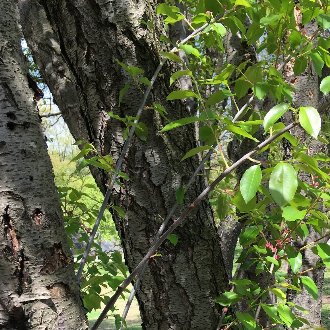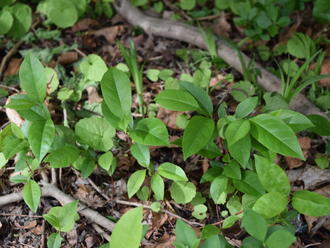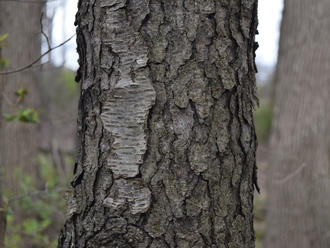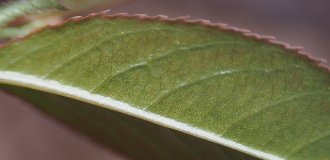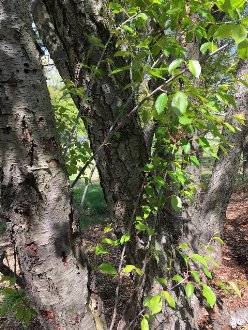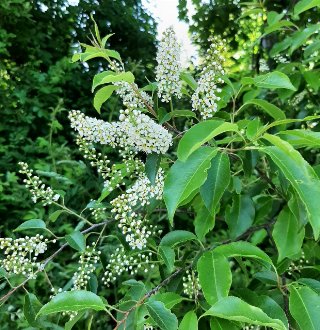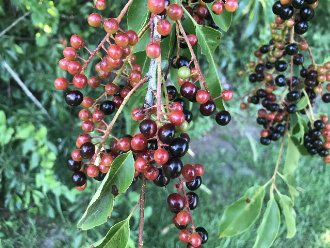Black Cherry (Prunus serotina Ehrh.)
Also known as wild black cherry.
↑Summary
The largest tree of the Prunus genus in much of its range, the black cherry is a major component of Eastern forests, especially younger forests.
↑Range - Expand
| Legend | Color |
| Native | |
| Native or Not Present | |
| Introduced or Not Present |
This tentative map is based on our own research. It may have limited data on Canada and/or Mexico, and there is some subjectivity in our assignment of plants as introduced vs. expanded. Read more in this blog post.
Although this plant occurs somewhere in each of these regions, it may only occur in a small part of some or all of them.
↑Habitat
Found primarily in early-successional woodlands, such as those that form following logging, abandonment of agricultural land, windthrow, or fire. Also found in edge habitats and narrow forest fragments or rows of trees, and in some more open habitats such as savannas and moist bottomlands of arid regions. This species has a large range and its habitat requirements vary regionally.
Found on sites with a variety of moisture conditions, but most abundant on mesic sites. In most of its range, tolerates a wide variety of adverse soil conditions: especially tolerant of acidic soils, and moderately tolerant of rocky soils and poorly-drained clay. Most frequently found on soil textures rainging from sandy loam to silty clay loam, often with fragipans preventing drainage and root growth beneath a thin surface layer.
Most abundant on the Allegheny plateau, where it is found on all soil types and generally most common on east- and north-facing slopes at lower elevations. More common at higher elevations in the southern Appalachians, and in this region, more restricted to sites with richer soils. In the north of its range, found on relatively drier sites, such as oak forests and savannas in southern Wisconsin. In areas around the Great Lakes it is more demanding of deep, well-drained soils and less common on poorly-drained sites. In the southwest, confined to canyons and bottomlands.
Absent from mature closed-canopy forests except where isolated disturbance, such as windthrow, has occurred.
Humans have increased the prevalence of this species, primarily through logging which tends to result in the release of large number of black cherry seedlings to full sun, and through the creation of more edge habitat and isolated, narrow forest fragments or rows of trees.
↑Life Cycle
Seeds sprout in spring; germination requirements are relatively low, and seeds germinate easily in a wide range of moisture and lighting conditions. Germination is slightly better on moist seedbeds, and slightly better in loose soil and leaf litter than on mineral soils.
Under favorable conditions, seedlings grow quickly, as much as 2-4 inches in one month. Heavily shaded seedlings grow slowly, as little as 6 inches in 3-4 years. Shaded seedlings typically survive for a few years but eventually die after about the 4th year if not released from shade. However, in some drier, more open habitats such as bur oak savanna, shade-suppressed seedlings can persist as long as 40-60 years by dying back to the root and then resprouting, much in the same way most oaks do.
If seedlings are released from shade, they grow rapidly.
Seed production typically peaks between 30 and 100 years of age. There is some seed production every year, with bumper crops occurring irregularly at 1-to-5 year intervals. Seeds are mostly distributed by birds, with some also distributed by mammals and many just by gravity, falling close to the parent tree. Most seeds are viable; seeds require cold dormancy for germination.
Seeds form a short-term seed bank, with only a small portion germinating in the first year, and some germinating the second or third year, but few surviving longer-term. This species thus maintains both a short-term seed bank, and a short-term bank of seedlings in shade-suppressed area, extending from 1-7 years following seed distribution.
Above-ground parts of adult trees are relatively susceptible to fire, but root systems and seeds are more resilient. Above-ground parts of larger trees can sometimes survive low-intensity surface fires.
Trees top-killed by fire or cutting resprout vigorously from the trunk; rate of resprouting is high for trees as old as 60 years of age, older than typical for hardwoods, as many hardwoods only resprout vigorously when younger.
Trees can be killed by insect infestations or fungus or other pathogens; major pathogens affecting this species include black knot (Dibotryon morbosum) and Leucostoma canker (Cytospora leucostoma). Some trees die of rot of the roots and underground portions of the trunk, which tends to progress slowly in this species. Trees are also susceptible to windthrow, due to the combination of this species being shallow-rooted and tending to grow taller than most of its associates.
The average lifespan of mature trees is closer to 100 years, but some individuals can live as long as 250 years.
↑Faunal Associations
Black cherry is one of the most important of the eastern deciduous species in terms of the wildlife it supports. The fruit is an important food source to many birds, including songbirds and various upland game birds, and is also eaten by mammals including the black bear, gray fox, red fox, eastern chipmunk, various squirrel species, oppossom, raccoon, and white-footed mouse. These animals also help spread the seed to new areas.
White-tailed deer browse on leaves and twigs, which contain cyanide compounds, limiting the quantity that can be consumed. This species is responsible for poisoning livestock, most of which are not adapted to its presence and will consume unsafe amounts if left to their own devices; the wilted leaves are particularly dangerous.
The flowers are insect-pollinated and attract honeybees, bumblebees, halictid bees, andrenid bees, syrphid flies, blow flies (Calliphoridae), and other flies. In addition to nectar provided by the flowers, this tree also has extrafloral nectaries, which attract and support ants, which defend the leaves against insect herbivory. In spite of this protection, the leaves are eaten by a wide array of insects, including hundreds of Lepidoptera species (butterflies, skippers, and moths) supported in the larval phase. In addition this tree is eaten by numerous beetles, sawfly larvae, and other insects.
Most of these insects cause little harm to trees; however, infestations of the eastern tent caterpillar (Malacosoma americanum) and the cherry scallop
shell moth (Rheumaptera prunivorata) can cause major damage, reducing growth of healthy trees and sometimes killing already-stressed trees.
↑Uses
This species is a key species for timber. Its wood is considered one of the most easily workable woods. The heartwood develops a reddish brown color with age, and is highly decay resistant; the sapwood is lighter in color and a bit less durable. Because it is so common and easily regenerates after harvest, it is more sustainable and tends to have a lower price than other woods of similar quality. It is mostly used in cabinetry, high-quality furniture, flooring, veneer, and various small objects.
The fruit is edible but small in size and is not typically cultivated or harvested for fruit. The relative sweetness of the fruit varies from tree to tree; some are quite bitter, but this species generally is more palatable than some Prunus species and has a relatively low astringency. One advantage of this fruit, however, is that it tends to come later in the summer than most commercial cherries.
Black cherry is occasionally used as a landscaping plant. It is generally easy to grow, and it is valued for its showy flowers and support of wildlife, but its commercial use is limited by the fact that young plants tend to have a deep taproot and are difficult to transplant. Because this plant is so widespread, if you want to grow it in landscaping it is often most effective to simply clear space for it and wait for one to come up in a spot where you want it.
This species has also been used successfully for reclaiming mine spoils in the east. To this end, the best results were obtained by planting trees that had been grown for at least a year in a nursery setting. Farther west, in Missouri, Kansas, and Oklahoma, similar attempted plantings had a poor survival rate.
↑Related Plants
Numerous other Prunus species, both native and introduced, co-occur with this one in North America. Genetic analyses have suggested that this species is probably most closely-related to a group of three species native to China and not occurring in North America: P. incisoserrata, P. hypoleuca, and P. hypoxantha.
Of trees that actually occur in North America, this species is probably closest-related to the native chokecherry (Prunus virginiana), which overlaps in the north of this species range but is absent in the south, and the introduced European bird cherry (Prunus padus), which has only established on scattered sites.
Beyond these, it is next-closest related to other members of the Padus subgenus, which includes the Carolina laurelcherry (Prunus caroliniana), overlapping slightly in range, and West Indian cherry (Prunus myrtifolia), which does not overlap with this species in range. No other members of this subgenus are found in North America.
↑Links & External Resources
• Black Cherry | The Wood Database (About This Site)
• Black Cherry | Fire Effects Information System (FEIS) (About This Site)
• Prunus serotina (Wild Black Cherry) | Illinois Wildflowers (About This Site)
• Prunus serotina (Black Cherry) | USDA PLANTS Database (About This Site)
• Prunus serotina | Go Botany (About This Site)
• Prunus serotina (Black Cherry) | Missouri Botanical Garden Plant Finder (About This Site)
• Black Cherry | Virginia Tech Dendrology Factsheets (About This Site)
• Black Cherry | Silvics of North America (About This Site)
• Prunus serotina | Biota of North America Project (BONAP) (About This Site)
• Prunus serotina | NatureServe Explorer (About This Site)
• Prunus serotina | Flora of North America (About This Site)
• Prunus serotina | Missouri Plants (About This Site)
• Black Cherry | Maryland Biodiversity Project (About This Site)
• Prunus serotina Ehrhart ssp. serotina (Black Cherry, Wild Black Cherry) | Digital Atlas of the Virginia Flora (About This Site)



